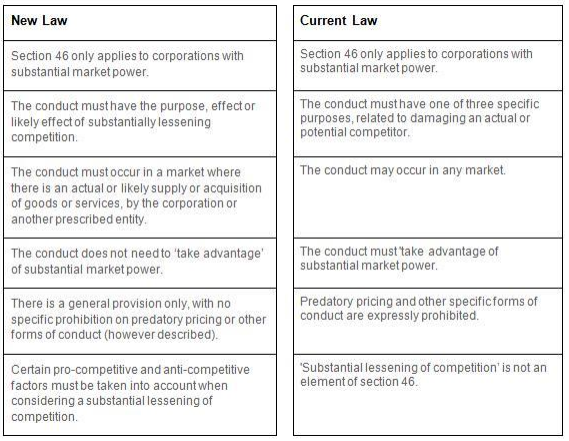4 December, 2016
On 1 December 2016, the Federal Government took a further step towards implementing the Harper Review recommendations regarding the prohibition against misuse of market power in the Competition and Consumer Act 2010 (CCA), with the introduction in the House of representatives of the Competition and Consumer Amendment (Misuse of Market Power) Bill 2016 (Bill). The introduction of the Bill follows public consultation on the Exposure Draft of the Competition and Consumer Amendment (Competition Policy Review) Bill 2016 (Exposure Draft) released on 5 September 2016.
While the Exposure Draft contained a range of substantive amendments to the CCA arising out of the Harper Review recommendations, the Bill only deals with proposed changes to the misuse of market power prohibition (as well as some telecommunications specific provisions).
The proposed amendments to misuse of market power set out in the Bill are largely identical to those proposed in the Exposure Draft. For further information on the Exposure Draft, see our earlier alert New Laws to introduce "effects test" for misuse of market power.
The consultation period for the balance of the Exposure Draft was extended until 28 October 2016. Bills implementing the balance of the proposed changes have not yet been introduced. Changes to the current misuse of market provisions The current prohibition against misuse of market power in section 46 of the CCA prohibits a corporation that has a substantial degree of market power from taking advantage of that market power for one of three proscribed anti-competitive purposes.
The Bill introduces a revised section 46 aiming to strengthen the current prohibition on misuse of market power and better target anti-competitive unilateral conduct by corporations with a substantial degree of market power.
In particular, the revised section 46: removes the requirement that a corporation 'take advantage' of its substantial market power; replaces the current 'purpose test' with a new test that prohibits a corporation with substantial market power from engaging in conduct that has the purpose, effect or likely effect of substantially lessening competition; and provides mandatory but non-exhaustive factors which must be considered in determining whether there has been a substantial lessening of competition (set out below). There has been one important change to the proposed amendments set out in the Exposure Draft. Under the Bill, the market in which the conduct giving rise to a misuse of market power must occur is limited to only those other markets in which the corporation supplies or acquires (or is likely to supply or acquire) goods and services. Under the Exposure Draft, the prohibition applied to conduct which had the purpose, effect or likely effect of substantially lessening competition in any market. This change was made in response to stakeholder consultation revealing a concern about the broad scope of section 46 applying to conduct in "any market". Comparison of new law and old law The Bill contains a useful comparative table between the section 46 elements of the current law and the proposed law, which is extracted here.
Please click on the image to enlarge.
Bill requires a holistic approach to be taken to substantial lessening of competition analysis The Bill introduces a requirement that certain pro-competitive and anti-competitive factors must be taken into account in assessing whether conduct has the requisite purpose, effect or likely effect of substantially lessening competition in a market.
Specifically: the pro-competitive factors include whether the conduct has the purpose or effect of enhancing efficiency, innovation, product quality or price competiveness in the market; and the anti-competitive factors include whether the conduct has the purpose or effect of preventing, restricting, or deterring the potential for competitive conduct or new entry into the market. The Explanatory Memorandum to the Bill explains that:
"The requirement to consider both anticompetitive and pro-competitive conduct emphasises that section 46 is not intended to capture conduct that is pro-competitive overall". Further, the requirement to consider pro-competitive aspects of conduct means that they are not "left out of a holistic analysis of the conduct".
The Explanatory Memorandum notes that it is possible that in certain circumstances one anti-competitive factor or one pro-competitive factor may so significant as to outweigh the other factors. What's next? After being introduced and read a first time in the House of Representatives, the Bill was referred to the Senate Economics Legislation Committee for review, with a report due on 16 February 2017.
For further information, please contact:
Georgina Foster, Partner, Baker & McKenzie
georgina.foster@bakermckenzie.com






